Synthetic chemistry
The synthetic chemistry research theme encompasses organic and inorganic chemistry and spans a broad range of applications with a focus on the preparation and characterisation of new molecules and materials using synthetic chemistry techniques.
Research activities in this theme are spread across three fully-equipped research laboratories in the Lennard-Jones Laboratories building at Keele and make use of our state-of-the-art analytical facilities.
Research in this theme also includes crossover with the materials science research theme as well as collaborations with the School of Life Sciences at Keele and external collaborators in the pharmaceutical industry.
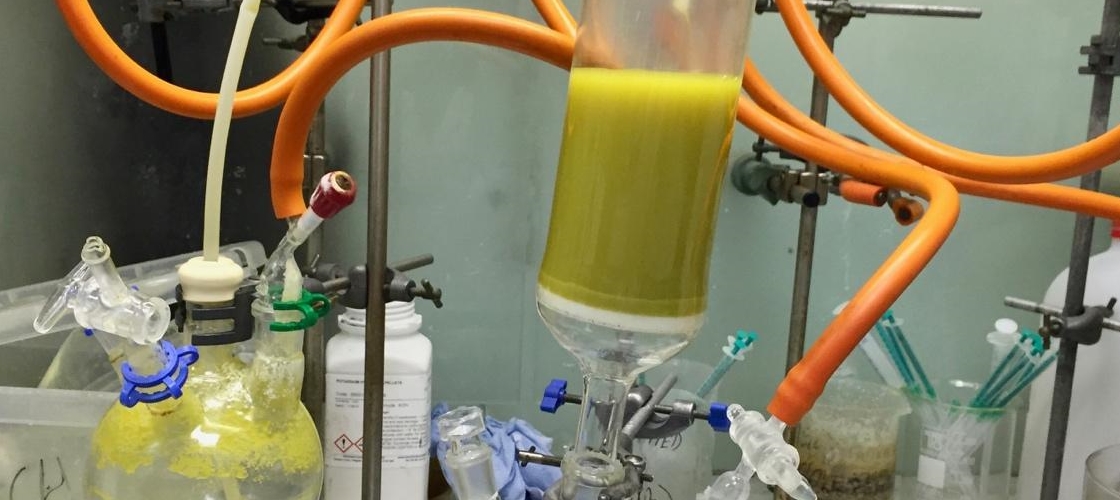
The developing world has an insatiable desire for energy in terms of both production and storage, and to meet these twin challenges we rely on a fascinating array of functional materials. One strategy to improve the properties of materials is to include small amounts of other elements which act as dopants, but it can be unclear as to what is the exact structural relationship between the bulk material and the dopants that give rise to the desired properties. We seek to make molecular models of the wider materials as this allows us to determine the exact positional relationships between atoms and so we can predict how we might improve the expected functionality.
Specific projects in the group are currently focused on looking at the structures in III-V quantum dots and developing nanomaterials for H2-storage.
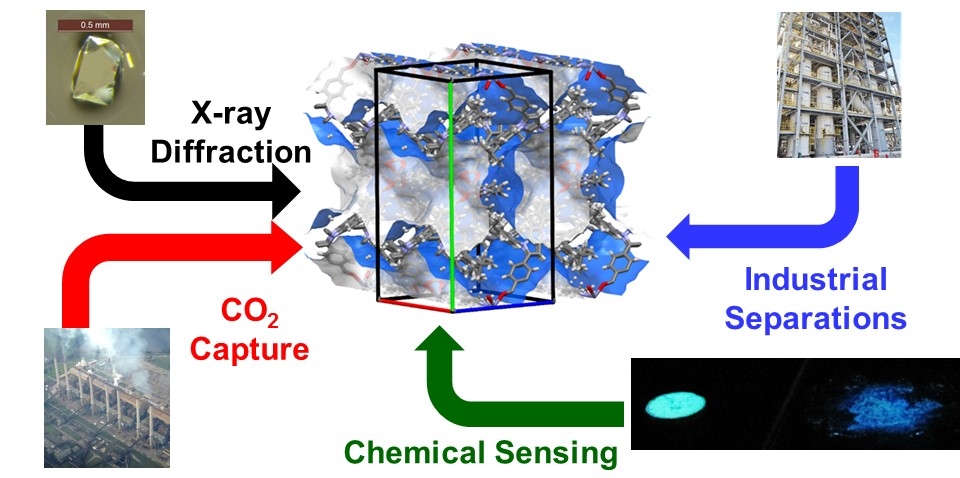
Research in the Hawes group is based around synthetic and structural aspects of supramolecular coordination chemistry, and the synthesis of responsive materials, with a particular focus on Metal-Organic Frameworks (MOFs). Our goal is to synthesise and characterise new crystalline materials with functionality controlled by the design of the organic ligands. These materials have numerous uses, but our focus is on developing water-stable materials for chemical separations (separation of liquid or gaseous hydrocarbons, and CO 2 capture), and chemical sensing with fluorescent or colorimetric MOF-based sensors. This research heavily involves single-crystal X-ray diffraction to probe the fascinating structural chemistry of both discrete and polymeric coordination compounds. As well as a large synthetic chemistry component, our research involves a wide variety of physical and spectroscopic characterisation techniques. These projects are fundamentally interdisciplinary, with support from international collaborators, and geared towards new research directions both in fundamental science and applied towards pressing environmental needs.
For more information please visit the group research pages and follow us on Twitter.
Our research is targeted in the broad area of molecular synthesis and its interdisciplinary application in medicinal chemistry. We aim to develop new and efficient methods to prepare interesting molecules and apply them to interesting problems. We work with a range of collaborators inside and outside of Keele to accomplish these goals. Two currents projects of interest focus on targeted autotaxin inhibitors as a therapy for Ovarian Cancer and novel anti-malarial agents.
Ovarian tumours represent a challenging drug target due to the poor pharmacokinetic properties of drugs which target them. We are examining methods for the more effective treatment of such tumours by investigating delivery methods for inhibitors which target autotaxin, an enzyme which plays an important role in the proliferation of ovarian tumours, and have reported two distinct delivery systems that enhance the properties of autotaxin enzyme inhibitors.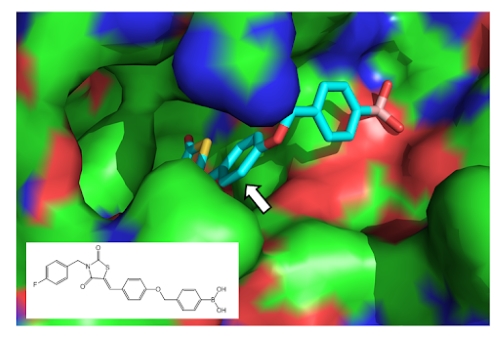
Above: The image shows the x-ray structure binding of the potent inhibitor HA155 to the enzyme target. A delivery molecule was attached at the position indicated with an arrow to improve the pharmacokinetic properties of the inhibitor.
Malaria continues to be an endemic worldwide problem with increasing resistance of the malaria parasites to current drug therapies. This presents a need for new chemotherapies that are not only potent but rapidly kill the parasite. We have been exploring the structural activity of a number of interesting heterocycles series based on leads discovered by the Medicines for Malaria Venture (MMV).
Stereoselective Synthesis of Natural Products
We are interested in the diastereoselective synthesis of key motifs found in biologically active natural products. Recent work has focused on the use of epimerisable chiral centres on conformationally well-defined scaffolds such as tetrahydropyran and piperidine rings. By combining two epimerisable groups and a single configured chiral centre, we are able to achieve double diastereoselectivity and produce a single product from four possible stereoisomers (J. Org. Chem., 2017, 82, 3441)

Continuous Flow Synthesis and Low Cost Automation:
We are interested in the use of continuous flow synthesis as an enabling technology for chemical research. In particular, we have been involved in the development of reactors that facilitate efficient gas-liquid contact in flow (e.g. Teflon AF-2400 Tube-in-Tube reactors) as well as separation systems that permit inline extraction and purification of product flow streams (e.g. liquid-liquid flow contactors/separators). J. CO2 Util. 2017, 21, 580, Tetrahedron, 2018, 74, 6795
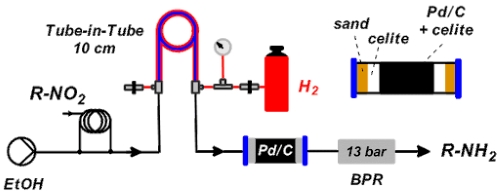
Additionally, we have also incorporated our reactors and separators into a series of low-cost automated synthesis and analysis platforms that harness emerging open-source hardware and software technologies (e.g. Python, Scipy, OpenCV, RAMPS). Tetrahedron, 2018, 74, 3152
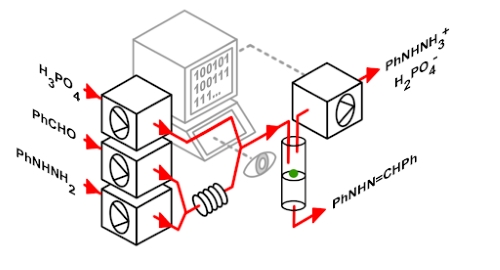

Our independent research has focussed on the design of ligands for functional complexes for many years. We have a long-standing interest in the application of biomimetic manganese complexes in oxidative catalysis for applications in both synthetic chemistry and in low temperature laundry. Here the main drive has been to develop systems capable of oxidising hydrocarbon substrates with good selectivity and in high yield using the environmentally benign oxidant hydrogen peroxide. Our man focus of activity in recent years has been on the development of small molecule fluorescent probes for the detection of ‘mobile’ zinc. This is the second most abundant d-block metal in humans and whilst much of the element is present in bound forms, there exists a pool of ‘mobile’ or ‘free’ zinc whose concentration varies enormously in cells and is known to be associated with a number of important disease states including type II diabetes mellitus and certain cancers. Owing to its d10 configuration and lack of spectroscopically useful nuclei, it is generally imaged using fluorescent probes and our efforts focus on the development of small molecule probes that use a switch off of Photo-induced Electron Transfer (PET) as a detection mechanism. We are also actively engaged with a pan-European collaborative network of scientists interested in zinc, Zinc-Net, that was established following support through TD1304 COST Action. Finally, we have a long-standing collaboration with Steffi Krause from The School of Engineering and Materials Science at Queen Mary, the University of London where our collaborative research focuses on two main areas: i) Biosensors and ii) Electrochemical imaging. In both cases, we use synthetic chemistry to develop materials capable of delivering functional applications in real-world settings.

The group's research is focused on the chemical and chemoenzymatic synthesis of carbohydrates. This is undertaken to create new probes for chemical glycobiology and for the application of nonnative carbohydrate structures in medicinal chemistry. We are also interested in the growing requirement of carbohydrates as biomaterials, especially from the perspective of accessing materials to understand polysaccharide structure-function relationships.
For more information please email me or visit the group research pages and follow us on Twitter.
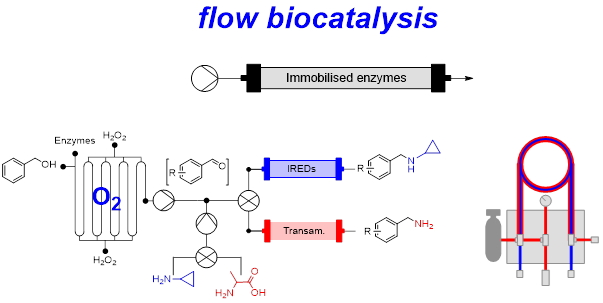
The research in our group focuses on the use of enzymes for organic synthesis. In particular, we are interested in process innovation for the improvement of biocatalyst performance. This includes the use of flow reactors (often coupled with enzyme immobilisation) to allow for the design of new (chemo)enzymatic cascades that could not be achieved using typical batch methods. Recent paper: Development of Continuous Flow Systems to Access Secondary Amines Through Previously Incompatible Biocatalytic Cascades.
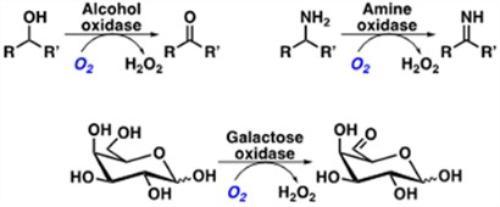
We are also broadly interested in the use of oxidase enzymes for synthesis. They are often solely dependent on molecular oxygen as an external oxidant and proceed under ambient conditions, offering many advantages over classical stoichiometric methods (e.g. chromium based reagents).
Currently, we are investigating alcohol oxidases for remediation purposes with an industrial partner, as well as how flow can be used to accurately determine kinetic oxygen requirements for oxidases.
If you are interested in any of the group's research or anything associated with biocatalysis and would like to work with us in Keele (DPhil, PhD or Postdoctoral), then please get in touch via email (s.cosgrove@keele.ac.uk) to discuss potential funding options.
Follow on Twitter for research updates (@scosgrove123).


